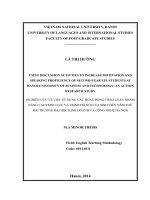- Trang chủ >>
- Mầm non - Tiểu học >>
- Lớp 5
5 5 3 astronauts and cosmonauts (space and technology)
Bạn đang xem bản rút gọn của tài liệu. Xem và tải ngay bản đầy đủ của tài liệu tại đây (5.03 MB, 14 trang )
Suggested levels for Guided Reading, DRA,™
Lexile,® and Reading Recovery™ are provided
in the Pearson Scott Foresman Leveling Guide.
Space and Technology
A stronauts
and
C osmonauts
Genre
Expository
nonfiction
Comprehension
Skills and Strategy
• Author’s Purpose
• Compare and
Contrast
• Monitor and Fix Up
Text Features
•
•
•
•
Captions
Diagram
Headings
Glossary
by
Joanna Korba
Scott Foresman Reading Street 5.5.3
ISBN 0-328-13570-4
ì<(sk$m)=bdfhah< +^-Ä-U-Ä-U
Vocabulary
aerospace
beleaguered
capsule
dissolved
germinate
Reader Response
A stronauts
and
C osmonauts
1. What is the author’s purpose in writing this book?
2. Use a Venn diagram like the one below to compare
and contrast the way astronauts and cosmonauts
trained for their missions.
Astronauts
Cosmonauts
Both
gravity
rendezvous
simulator
strenuous
Word count: 2,882
by Joanna Korba
3. Notice the word germinate on page 18. What is
another meaning for this word? Write a sentence
using germinate with this other meaning. Now do the
same for the word gravity.
4. Would you like to be an astronaut? Explain your
answer.
Note: The total word count includes words in the running text and headings only.
Numerals and words in chapter titles, captions, labels, diagrams, charts, graphs,
sidebars, and extra features are not included.
Editorial Offices: Glenview, Illinois • Parsippany, New Jersey • New York, New York
Sales Offices: Needham, Massachusetts • Duluth, Georgia • Glenview, Illinois
Coppell, Texas • Ontario, California • Mesa, Arizona
From the dawn of human history, people have
gazed at the heavens in wonder. Early cultures
created myths to explain why the night sky was
sprinkled with stars. Over the centuries, earthbound
observers and scientists gathered knowledge about
the heavens. They learned that, out there in the
vastness of space, other planets existed beyond ours.
In 1955, two countries boldly declared that they
planned to take a closer look at these other worlds.
Both the United States and the Soviet Union—which
was a nation made up of Russia and its neighbors—
announced their intention to launch artificial
satellites. This was no joint mission, however. The
two countries were fierce rivals.
Every effort has been made to secure permission and provide appropriate credit for
photographic material. The publisher deeply regrets any omission and pledges to
correct errors called to its attention in subsequent editions.
Unless otherwise acknowledged, all photographs are the property of Scott Foresman,
a division of Pearson Education.
Photo locators denoted as follows: Top (T), Center (C), Bottom (B), Left (L), Right (R),
Background (Bkgd)
Opener ©Bettmann/Corbis; 1 ©Royalty-Free/Corbis; 3 ©Tony Freeman/PhotoEdit;
4 ©Marc Garanger/Corbis, 4 ©Bettmann/Corbis; 7 ©Kazak Sergei/ITAR-TASS/Corbis;
9 ©Jim Sugar/Corbis; 10 ©Rykoff Collection/Corbis; 12 ©Rykoff Collection/Corbis;
13 NASA; 15 ©Bettmann/Corbis; 16 ©NASA/Roger Ressmeyer/Corbis; 19 Carol Stutz;
20 ©Royalty-Free/Corbis
ISBN: 0-328-13570-4
Copyright © Pearson Education, Inc.
All Rights Reserved. Printed in China. This publication is protected by Copyright,
and permission should be obtained from the publisher prior to any prohibited
reproduction, storage in a retrieval system, or transmission in any form by any
means, electronic, mechanical, photocopying, recording, or likewise. For information
regarding permission(s), write to: Permissions Department, Scott Foresman, 1900 East
Lake Avenue, Glenview, Illinois 60025.
4 5 6 7 8 9 10 V0H3 14 13 12 11 10 09 08 07 06
3
The Race
This rivalry between nations grew after World
War II, and the quest for space-age technology
grew out of both nations’ desire to have the most
accurate, most powerful defense systems. At first the
United States put more research into bombers, while
the Soviet Union focused their research on missiles.
That is how the Soviet Union made unexpected
advances in rocket technology.
While the United States was still deep in the
development of its first satellite, the Soviet Union
astonished the world by launching its satellite,
Sputnik, on October 4, 1957. Sputnik means
“traveling companion” in Russian. About the size of
a basketball and weighing 183 pounds, tiny Sputnik
managed to orbit Earth in just 98 minutes. One
In 1957, the Soviet Union sent
Sputnik and Sputnik II into space.
4
month later, the Soviets sent up Sputnik II with a dog
named Laika inside.
The United States, caught off guard when the
Soviet Union had beaten them into space, vowed to
catch up to their rivals—and pull ahead. The “space
race” had begun.
The first satellites launched by the United States—
Explorer 1 and Vanguard 1—were significantly
smaller than either Sputnik or Sputnik II. U.S. rockets
at the time were much less powerful than their
Soviet counterparts.
As part of its commitment to the space race, the
United States created the National Aeronautics and
Space Administration, known more commonly as
NASA. This civilian agency centralized the efforts of
politicians, the military, the aerospace industry, and
university researchers.
One of NASA’s publicly stated goals was to launch
a person into space. The Soviets were not so open
about their objectives. They worked hard to keep
their missions and timetables secret from the rest of
the world—and especially from the United States.
But everyone knew that it was only a matter of time
before human beings—Americans or Soviets—would
be sent into space.
Interestingly, the two countries used remarkably
similar terms for their would-be space travelers.
Both drew on the Greek word for sailor, nautes.
The Soviets combined nautes with the Greek word
cosmos, meaning “universe.” They called their space
travelers cosmonauts. The United States combined
nautes with the Greek word astron, meaning “star,”
to come up with the term astronauts.
5
The Training
As their space programs went forward, the United
States and the Soviet Union developed intensive
training programs for the human beings they
planned to send into space. There were—and still
are—similarities and differences in the training of
astronauts and cosmonauts.
Both astronauts and cosmonauts were expected
to be extremely fit, undergoing strenuous exercise
programs and maintaining healthful diets. Astronaut
and cosmonaut physical training was similar,
although the Soviet model tended to be more
structured and strictly planned.
Astronauts were primarily educated in “handson” situations. NASA relied heavily on training
simulators, or “sims.” These mechanical devices
attempted to imitate the flight conditions that
astronauts would be likely to encounter in space.
The first United States astronauts were selected
from among military test pilots and engineers for
what was named the Mercury Program. Since no
one really knew what situations actually awaited
a human venturing outside Earth’s atmosphere,
many of the simulations that NASA developed
were a matter of educated guesswork. The Mercury
astronauts worked with NASA engineers to build
simulations. In that way, the astronauts helped train
the people who were finding ways to train the
astronauts!
6
Astronauts and cosmonauts must pass a battery of physical
tests before being cleared for a space mission.
By contrast, the Soviets relied more on pencil-andpaper training. Cosmonauts were mainly taught in
a classroom setting, rather than in simulators. They
listened to instructors, took notes, asked questions, and
then took oral examinations on what they had learned.
Cosmonaut training continues to be largely in the
classroom, although simulators are now used as well.
Recently, NASA added formal testing to its astronaut
training, although it still relies heavily on “sims.”
While their training may have differed in some
ways, it was directed to the same challenge. Both
astronauts and cosmonauts had to learn how to live
and work under conditions found nowhere on Earth.
For example, they had to become accustomed to
weightlessness.
7
Every bit of matter, whether it is large or small,
pulls on every other bit of matter. This is what is
called gravitational force. Earth exerts this force on
every object found on its surface, including us. We
refer to Earth’s gravitational force as gravity. One
of the major challenges facing space travelers is
that gravitational force is either very weak—almost
entirely lacking—in outer space. Everything not tied
down—objects, living things, even liquids—simply
floats about in a spaceship, basically weightlessly.
How could the United States’ and Soviet training
programs simulate weightlessness? They came
up with similar solutions. The Soviets mounted a
simulated spacecraft cabin in a Tupolev-104, a twinengine passenger jet plane. The cosmonauts entered
this cabin. Then the plane soared straight up, turned
quickly, and dived downward. Everything on board,
including the cosmonauts, became weightless for
about half a minute.
The astronauts, meanwhile, were training on a
special KC-135 plane affectionately known as the
“vomit comet.” This plane was flown in a similar
manner to the Soviet’s Tupolev-104 and produced
the same thirty seconds of weightlessness.
8
Some trainees get sick during their half-minute of
weightlessness. Those that do are likely to suffer initially from
spacesickness when in space.
Another kind of “weightlessness” training is used
for astronauts who are going to be wearing bulky
spacesuits as they walk—and work—in space. Much
of the training is done in a specialized swimming
pool. Although not weightless, the astronaut
maneuvering around in water in a spacesuit gets a
feel for what it will be like floating in space.
Today’s astronauts train underwater in huge
tanks fitted out as space shuttle chambers and as
the International Space Station. With such training,
astronauts will be familiar with conditions on these
craft before they actually board them.
9
The First People in Space
After the surprise of the Sputnik launch, the
United States vowed to catch up with the Soviets
and surpass them. In 1961, NASA announced that it
would be sending the first human being into space.
The launch was set for May 5, and the astronaut
selected was Mercury astronaut Alan B. Shepard,
Jr. The Soviets, working in secret, redoubled their
efforts to be the first nation to launch a human into
space. They succeeded—by barely three weeks.
On April 12, 1961, a Soviet Air Force pilot named
Yuri A. Gagarin became the first human to travel
into space. His spaceship was named Vostok 1.
Vostok means “east.” Vostok 1 was controlled by
an automatic guidance system. In other words,
Yuri Gagarin was not flying the spacecraft himself.
Vostok 1 took 108 minutes to orbit Earth once before
landing safely.
After his historic flight,
Gagarin did not fly again
but continued to work on
the Soviet space program.
The banner here says,
“12 April 1961, Vostok.”
10
The United States continued with its scheduled
launch. Shepard flew inside a cone-shaped capsule
named Freedom 7 that weighed about 3,000 pounds.
The capsule was launched into space at the tip
of a tall rocket. As the rocket sped out of Earth’s
atmosphere, parts of it fell away as they were no
longer needed.
Shepard lay on a contour couch during his brief
fifteen-minute flight. Shepard had hoped to orbit
Earth, as Gagarin did, but NASA decided just to send
him into space and have him quickly return back to
Earth.
The first American to orbit Earth was John H.
Glenn, Jr., in the Friendship 7. On February 20, 1962,
he completed three orbits around Earth in less than
five hours. During that short time, he maneuvered
the capsule into different positions, tested its various
positions, and observed some dramatic events, which
he described for those back on Earth—including a
giant dust storm in Africa, a sunrise, and a sunset!
On June 16, 1963, the Soviets scored another first.
Cosmonaut Valentina Tereshkova, a Soviet pilot,
made forty-five orbits aboard Vostok 6 in a flight
that lasted just under seventy-one hours. She was the
first woman to travel into outer space.
11
Alexei Leonov
was the first man
to walk in space.
The First Space Walk
The first human “walked” in space
on March 18, 1965, when cosmonaut Alexei
Leonov, who had trained for two years, calmly stepped
out into the void of outer space. A camera mounted on
the outside of the capsule enabled millions of Soviet TV
viewers to share the moment with him.
There was a tense moment, though, when Leonov
tried to reenter his spacecraft. During the space
walk, his spacesuit had expanded a bit. He had to
slowly and carefully let air out of the suit before
he was able to fit through the hatch and enter the
capsule once again.
Less than three months later, on June 3, Ed White
became the first American to walk in space. His
two-man flight (he was accompanied by James A.
McDivitt) lasted four days, but his space walk lasted
only twenty-one minutes.
During the first minutes of the walk, White used
a handheld oxygen-jet gun to propel himself away
from the capsule and to the end of his lifeline. He
did this several times. When the fuel in the gun ran
out, White had to twist and turn and maneuver his
tether to get back to the hatch!
12
The First Moon Walk
The Soviets had accomplished a number of historic
firsts in the space race. But the grand prize was
looming on the horizon, and it would go to the first
nation to land a human on Earth’s moon.
The grand prize went to the United States. People
all over the world were glued to their television sets
on July 20, 1969, as the lunar module Eagle touched
down on our nearest neighbor in space. Six hours
later, the doors of the Eagle opened. Astronaut Neil
A. Armstrong emerged in his bulky spacesuit, climbed
down the ladder of the Eagle, and uttered his now
famous words as he stepped onto the moon: “That’s
one small step for man; one giant leap for mankind.”
He was soon joined on the moon by his Eagle
crewmate Buzz Aldrin. The two astronauts spent
about two-and-a-half hours gathering moon rocks,
taking photographs, and drilling core samples from
the moon’s surface. They planted the American flag
at their landing site and left a plaque behind. It said,
“We came in peace for all mankind.”
13
Teamwork in Space
Since the space race began, the United States
and the Soviet Union had been locked in fierce
competition. That situation began to change in the
early 1970s. In 1972, the two former rivals agreed to
work together on what came to be called the ApolloSoyuz Test Project. It was the first human spacecraft
mission to be coordinated by two nations. The goal
of the project was for a U.S. Apollo spacecraft and
a Soviet Soyuz spacecraft to rendezvous in space,
maneuver into position, and attempt to dock.
The American Apollo spacecraft was the same
design as those used on flights to the moon. The
Soyuz (meaning “union”) had been the Soviets’
primary spacecraft since 1967. Each nation’s
spacecraft had been developed independently. The
test project would enable the two countries to check
the compatibility of their systems in hopes of paving
the way for future joint space projects.
The plan called for the Soyuz to go up first, with
the Apollo arriving later for the rendezvous. For
practical reasons, and also as a sign of cooperation and
respect, the Americans agreed to speak Russian for
the mission, while the Soviets agreed to speak English.
Everyone involved on the project had to learn the
design and systems of the other country’s spacecraft.
The mission began on July 15, 1975, with the
launch of Soyuz. Apollo left seven hours later. The
successful docking took place on the afternoon
of July 21. Then two astronauts entered Soyuz,
exchanged gifts with the cosmonauts, and shared
a meal together. The next day, two cosmonauts
entered Apollo.
14
After the two spacecrafts separated, they
remained in space for a few days before returning
to Earth. The mission was judged to be an enormous
success. It proved that crewmembers could
transfer from one spacecraft to another. It enabled
crewmembers to conduct a number of important
scientific experiments. The United States and the
Soviet Union were able to work together effectively,
rather than compete against each other. It was a
huge leap forward for international cooperation.
The commander of the Soyuz
was Alexei Leonov, the first
human to walk in space. The
Apollo was under the command
of Thomas P. Stafford.
15
The Mir Space Station
On February 20, 1986, the Soviets launched a
space station that they called Mir (meaning “peace”).
Mir contained two docking ports, one at either
end, and four hatches. The hatches were designed
to accommodate the attachment of laboratory
modules. When the station was fully operational, Mir
would form the hub of a rimless wheel that had four
laboratory “spokes” radiating from it.
Completing the space station would take time.
Only so much equipment and supplies could be
brought up at a time. As the station was gradually
being assembled, a crew of cosmonauts was
constantly on board, except for a few months in
1989. Each crew might spend several months in space
before replacements arrived.
After the Soviet Union dissolved in 1991, Russia
(which had been the largest Soviet republic)
took over Mir. In 1992, Russia
entered into a joint project
with the United States known
as Shuttle-Mir. The plan was
for astronauts and cosmonauts
to work together as a team
on board the Mir. Each shuttle
mission would bring up needed
supplies, as well as a fresh crew
to relieve the team members who
had been in space for some time.
Eventually, other countries became
involved as well.
After some preliminary attempts,
the first successful shuttle docking took
16
place on Mir in late June 1994. The shuttle Atlantis,
with two cosmonauts aboard, replaced the crew (two
cosmonauts and an astronaut) that had come up a few
months earlier on a Russian Soyuz capsule.
On Mir, scientists who were part of the
cosmonaut/astronaut teams performed a number
of valuable experiments. For example, seeds
were planted to see how they would germinate
and develop in space. Also, protein crystals were
produced that are now being used in medical and
scientific research.
Although the Mir maintained a steady, breathable
mixture of air, it could not maintain a strong
enough gravitational force to keep
crewmembers from floating.
17
Mir’s crews gathered important data regarding
human beings’ ability to live in space over time.
The crewmembers, after all, were living in space for
several months. There was much less gravity on Mir
than on Earth. Researchers discovered that a person’s
bones could get weak quite quickly in space. The
weakening was most pronounced on the hips and
the spine. To combat this condition, the astronauts
and cosmonauts on board had to do special exercises
to help them maintain their bones and muscles.
In June 1997, an accident crippled Mir. A
cosmonaut was trying to dock an unmanned
spacecraft to the laboratory module (called Spektr).
The craft collided with Spektr, opening up a small
hole. When Spektr began to leak air, the crew had
to disable its power cables and close the hatch that
connected it to Mir. Although the crew lost some
valuable scientific data, a remarkable salvage effort
saved much of the work.
Soon after the accident, a mission arrived with
replacements for the beleaguered crew. During this
time, cosmonaut Vladimir Titov, in a U.S. spacesuit,
ventured out on a space walk with astronaut Scott
Parazynski. It was the first time a cosmonaut had
been dressed as an astronaut!
After the damage to Mir was repaired, work on
the space station continued until 2001. In March
of 2001, Russia guided Mir back to Earth, knowing
it would be destroyed during reentry. Most of it
burned up as it entered Earth’s atmosphere, and the
rest fell harmlessly into the Pacific Ocean.
Arm
Assembly
Hard Upper Torso
Communications
Carrier Assembly
Airlock Adapter
Plate
Display and
Control Module
Liquid Cooling
and Ventilation
Garment
Helmet/Extravehicular
Visor Assembly
EMU Electrical
Harness
Gloves
Primary Life
Support
Subsystem
Lower
Torso
Assembly
Secondary
Oxygen Pack
Contaminant
Control Cartridge
In-suit Drink Bag
Service and
Cooling Umbilical
Battery
18
19
The International Space Station
In 1984, then President Ronald Reagan authorized
NASA to design a large, permanent space station.
Eventually, the United States collaborated with
Russia, Brazil, Canada, Japan, and the European
Space Agency to create the station’s final design and
build it. Work began in 1998 and continued for many
years afterward.
20
In 2000, the first crew came aboard—two
cosmonauts and an astronaut—and proceeded to
move into the station. The people who would later
come to work here were from a number of different
countries. It is an international space station, after
all. In many ways, these people carry on the work
that was done on Mir—maintaining a station in space
and conducting scientific experiments. And as they
do their jobs, they (and
scientists back on Earth)
learn how to make living
and working in space better
and safer. There is still much
to learn. For example, how
long can people survive
safely in reduced gravity?
Will human beings ever
be able to build homes in
outer space?
We have come a long
way from the days of the
space race, when American
astronauts and Russian
cosmonauts were bitter
rivals. Not only have our
two countries found ways
to work together, but other
countries have joined in as
well. People of all nations
have come together to
learn and experiment as we
humans look for ways to
live among the stars.
21
Now Try This
Make a Plan for a Space Vacation
Everybody’s talking about taking this year’s
vacation in space. Suppose you had to plan a space
vacation. Just follow the instructions on the next
page. Here is a poem to inspire your ideas.
Come swim in the air,
in the air so fair
with no gravity.
Come live and dine,
on a diet so fine,
there’ll be no cavities.
Be gardeners, plant seeds
for protein needs.
Come stay in the space station.
Work out and get strong,
you can sing all day long
on your space vacation.
to Do It!
w
o
H
s
’
e
r
He
1. Design a vacation hotel for space. Begin by
making a list of ways that this hotel will be
different from one on Earth. Consider the
problem of no gravity.
2. Think about the types of things people might
want to do when they are on vacation in space.
How can your hotel help them do these things?
Write a paragraph to describe your answers.
3. How will people get to your hotel from Earth?
Write a brief paragraph explaining the travel
route.
4. Make a diagram of your hotel. Label different
areas of the hotel.
5. Create a brochure for your hotel. Remember
that the brochure should make people want to
visit your hotel.
Come for a vacation in space.
It is just the right place
to relax at your own pace.
And just in case
you need a race—
then race to our vacation in space.
22
23
Glossary
Vocabulary
aerospace
aerospace
adj. related
to the science and
technology
of flight.
beleaguered
beleaguered adj. beset by
troubles.
capsule
germinate v. to begin to
dissolved
sprout
or grow, as a plant
from a seed.
germinate
gravity
n. the force of
gravitation on Earth,
pulling
everything toward
gravity
its center.
Reader Response
rendezvous v. to meet
at a particular time and
place.
simulator n. an apparatus
or a device that creates
test conditions that are as
close as possible to reallife conditions.
1. What is the author’s purpose in writing this book?
2. Use a Venn diagram like the one below to compare
and contrast the way astronauts and cosmonauts
trained for their missions.
Astronauts
Cosmonauts
Both
strenuous adj. requiring
much energy and effort.
rendezvous
simulator
strenuous
Word count: 2,882
3. Notice the word germinate on page 18. What is
another meaning for this word? Write a sentence
using germinate with this other meaning. Now do the
same for the word gravity.
4. Would you like to be an astronaut? Explain your
answer.
Note: The total word count includes words in the running text and headings only.
Numerals and words in chapter titles, captions, labels, diagrams, charts, graphs,
sidebars, and extra features are not included.
24









